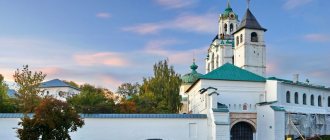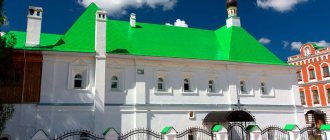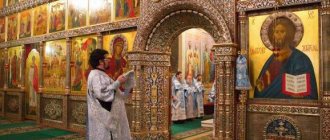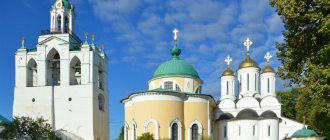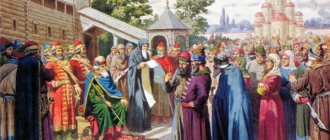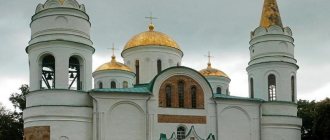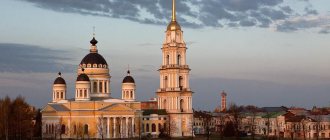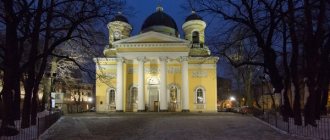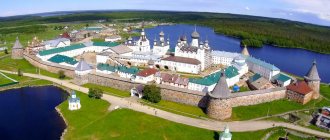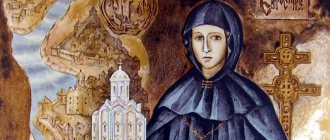Founders of the monastery
Solovetsky archipelago with an area of 347 square meters. km consists of 6 large and 100 small islands. People have been coming here for a long time, but no one dared to settle in a place completely cut off from the mainland by the turbulent waters of the White Sea from November to May.
The first permanent residents on the islands were the elder Savvaty and the young monk German . Here, on the edge of the earth, 165 kilometers from the Arctic Circle, they chose a silent and secluded place to serve God.
In 1429, on the Bolshoy Solovetsky Island, hermits erected a Cross of Worship and cut down modest cells, living for 6 years in labor and prayer. This is how monastic life began in a harsh region. Seeing the aliens, none of the worldly people dared to settle on the island.
In 1435, Herman went to the mainland, leaving Savvatiya. A year later, when he returned with a new brother, the monk Zosima, he learned that his like-minded person had died and was buried on the coast of the Vyg River.
Having settled in their cells, Herman and Zosima met believers arriving on the island who were looking for salvation from the world of temptations. In 1478, a monastic monastery and two wooden churches arose - the Transfiguration of the Lord and St. Nicholas the Wonderworker.
The Monk Zosima, who distributed property to the poor and joined the brotherhood of hermits, became abbot of the Solovetsky monastery and wrote the first charter defining the life of the brethren.
Five centuries of history of the Solovetsky Monastery
Like the fabulous Kitezh city, the Solovetsky Monastery rises from the cold waters of the White Sea. The outer rampart of wild red stone, the white walls of churches, chapels and monasteries, as well as countless golden crosses reflected in the sunlight, evoke admiration and admiration.
Overview of the complex
The main architectural ensemble of the Solovetsky Monastery is located on the shore of Blagopoluchiya Bay on the Big Solovetsky Island. The ensemble includes churches, residential and commercial buildings. The main entrance is the Holy Gate , leading to the cathedral complex: the Transfiguration and Assumption Cathedrals with a huge Refectory. The harsh appearance of the majestic buildings is brightened up by 3 churches: Trinity, Church of the Annunciation and St. Nicholas.
Separately there are stone chambers, a bell tower and a water mill, the oldest stone mill in Russia.
The pentagonal territory of the monastery is surrounded by massive walls 11 meters high and 6 meters thick. Against their background appear 8 formidable towers and 7 massive gates expanding downward. The walls, 1084 meters long, are built from huge smooth stones-boulders up to 5 meters in size and weighing up to 7 tons.
Temples and monasteries are connected externally by covered passages and surrounded by residential and utility buildings. In the central courtyard there are buildings with monastic cells. At the entrance to the monastery there is a sundial on the wall, which displays the time from 7 am to 5 pm.
The heyday of the monastery
In the 16th century, the Solovetsky Monastery enjoyed special patronage of the Moscow sovereigns. In 1447, at the Church Council, the Monks Zosima and Savvaty, Solovetsky wonderworkers, were glorified as saints.
The monastery received generous royal gifts from Ivan Vasilyevich the Terrible: land plots of the Sumy volost, bells and precious church utensils.
Abbess of St. Philip
During the years of the abbess of St. Philip (1548-1566), stone construction began in the monastery. Novgorod architects erected the Church of the Dormition of the Mother of God with a Refectory. The energetic abbot took up the task of renovating the monastery, which fell into disrepair after the devastating fire of 1485.
The abbot called on the monks to work hard, and the hitherto silent forests came to life. The hermits cut down trees, drained swamps and dug canals, built dams and paved roads, dug ponds and fertilized rocky soil for vegetable gardens. Numerous lakes were connected by canals and mills were installed on them, the monks raised fish in the ponds, and birch groves were laid out on the hills. The monastery economy developed: they started a farm on the island and brought in Lapland deer.
Through the efforts of Abbot Philip, the poor dwellings of the brethren were replaced by solid, spacious stone premises. Outbuildings were also built from brick: a brick and ironworks factory were built nearby for its production. Unusual lighthouses - high crosses - were installed near the harbor and pier.
In 1566, the main temple of the monastery was built - the Transfiguration Cathedral with the chapel of the Venerables Zosima and Savvaty, where the relics of the first founders of Solovetsky were transferred.
Diligently caring for the brethren, Abbot Philip himself served as the best example of leadership. During Philip's 18-year abbess, the monastery turned into a stronghold.
Tsar's oprichnina in the life of the monastery
The fame of Abbot Philip's righteous life reached Tsar Ivan the Terrible, who offered him the chair of Metropolitan of Moscow. Obeying the royal will, Abbot Philip accepted the rank.
The Metropolitan of All Rus' carried his title with dignity: he stood up for innocent people and boldly denounced the Tsar, for which the objectionable saint was exiled to the Tverskaya Oprich Monastery. In 1569, he suffered martyrdom at the hands of Malyuta Skuratov.
In 1591, at the request of Abbot Jacob to Tsar Fyodor Ioannovich, on behalf of all the brethren, the relics of St. Philip were transferred to the Solovetsky Monastery. In 1652, by royal decree, an embassy headed by Metropolitan Nikon arrived at the monastery.
He brought a letter in which Emperor Alexei Mikhailovich asks the great ascetic Philip for forgiveness of his ancestor. The Emperor expressed a wish to transfer the relics of St. Philip to the Assumption Cathedral of the Moscow Kremlin, which was done with great honor.
From that time on, the abbots of the Solovetsky Monastery were elevated to the rank of archimandrite. The monastery was exempted from paying duties and granted new lands.
Sovereign Fortress
At the end of the 16th century, the monastery received the status of a “great sovereign fortress” - it protected the northwestern borders of the Russian state. In 1578, Ivan the Terrible transferred artillery to the monastery-fortress, and 6 years later stone walls were erected, the construction of which took 12 years.
The monastery was surrounded by an 11-meter wall made of 7-ton smooth boulders. At the top of the walls there are loopholes for shelling the enemy , at the top of the towers there are lookout platforms. The guard duty was carried out by a detachment of archers who were supported by the monastery. Tsar Mikhail Fedorovich, understanding the role of the monastery in the defense of Pomerania, increased the number of “military people” to a thousand people.
The majestic Transfiguration Cathedral, connected by an underground passage to the Assumption Cathedral, looked like a fortress. The buildings were supplied with water from the Holy Lake and stored impressive supplies of food, weapons and gunpowder in case of a siege. The walls and towers of the monastery are so strong that no enemy force could damage them.
Military glory came to the monastery during the Crimean War. The well-fortified monastery became an important border fortress. 1025 inhabitants, possessing military skills, withstood a single, but very powerful bombardment by the British.
The cannonade, which lasted 9 hours, ended without result. Having fired 2 thousand bombs and cannonballs from their cannons, the frigates set off back. The defense was led by Archimandrite Alexander.
In 1858, Emperor Alexander II visited the monastery. The Tsar was accompanied by great princes and diplomats, writers and artists. They looked with amazement at the ancient relics, the rich sacristy and skillful church utensils, majestic churches and exemplary monastery facilities.
Solovetsky uprising
In 1657, Patriarch Nikon carried out a church reform, and new books were sent from Moscow to the monastery for worship. The Solovetsky Monastery remained faithful to the Old Believers: the monastic brethren did not support the changes in rituals, calling them heresy.
The monks wrote a petition to the king asking him to leave the old customs. For a long time, Tsar Alexei Mikhailovich hesitated, not daring to pacify the rebels by force. Only in 1674, the tsar sent an armed detachment to Solovki with the order to begin the siege of the monastery, which lasted 8 years and went down in the history of the fight against rebellious monks as the “Solovetsky seat.” The monks did not give up, they built fortifications, and some of the archers sent to pacify went over to their side.
The fortress fell on January 22, 1676: a traitor was found in the monastery, a young monk pointed out a hole walled up in the wall, through which the royal troops entered the fortification. A brutal massacre began: 30 monks, including Archimandrite Nikanor, were executed on the spot, the rest were killed later. The government confiscated the valuable property and estates of the monastery.
In 1702, the disgraced monastery was visited by Peter I; the emperor’s visit became evidence of the forgiveness of the rebellious fortress: the old estates were returned to the monastery and new lands were assigned.
Description and architectural features
There are monastery buildings on all four islands of the archipelago. The monastery complex is located on the largest island on the coast of Blagopoluchiya Bay. If you look at the monastery from above, it has a pentagonal shape and is surrounded on all sides by high walls. There are seven gates to enter the courtyard. Eight towers rise along the perimeter. The thickness of each wall at the base reaches 5 meters, at the top - 1.5 meters.
Some temples are connected to each other by covered corridors and are surrounded by residential and commercial buildings.
Spaso-Preobrazhensky Cathedral of the Solovetsky Monastery
In the courtyard of the Solovetsky Monastery there are the three-domed Assumption Church and the five-domed Transfiguration Church. Their architectural style is characterized by a special severity. Both buildings appeared during the reign of St. Philip. In addition, there are three churches: Trinity, Nikolaevskaya and Annunciation.
A special feature of the Transfiguration Cathedral is its unusual architectural design. The corner limits resemble fortress towers. The upper aisles stand on vaults and are connected by a system of covered passages. The corner chapters rise above them.
In front of the monastery courtyard there are two chapels, which were erected in honor of the royal visits of Alexander II and Peter I. They have not changed in appearance. Their construction dates back to the middle of the 19th century. There is another unusual detail that is not typical for Orthodoxy - there is a sundial at the entrance to the monastery.
A curious story is connected with the iconostasis of the Transfiguration Cathedral. During the “Solovetsky Sitting” it was taken from the temple by Old Believers. At the beginning of the 21st century, a Lithuanian announced that he had seven boards from this iconostasis and would sell them for 1 million 700 thousand euros.
Iconostasis of the Transfiguration Cathedral of the Solovetsky Monastery
The government of the country, having analyzed the situation and considered the expert opinion, considered such an acquisition irrational, allegedly due to the dubious authenticity of the relic. But in 2007, information appeared from unnamed experts about the originality of the legendary boards.
Monastic properties
The monastery owns numerous farmsteads and hermitages. Ancient churches and chapels, a biological station and a tar mill, a seaplane hangar and gun positions have been preserved here. Not far from the Holy Lake there are Gulag barracks and the camp administration building, ancient buildings.
In a picturesque hilly corner, in a basin surrounded on three sides by mountains, on the shores of Lake Lower Perth, lies the Makarievskaya Hermitage - the Botanical Garden of the Solovetsky Monastery, where 500 species of plants have adapted to life in the north.
Here the monks planted apple trees that have been bearing fruit for 130 years, berry bushes and cedars, and planted flower beds. Watermelons, melons, peaches and grapes ripen in heated greenhouses. In the apothecary's garden, medicinal plants are grown for the monastery hospital - all this is an example of what can be achieved through labor combined with prayer.
On the shore of the Igumen Lake there is the Filippova Hermitage , the favorite place of solitude of the Igumen Philip. Here, according to legend, Jesus Christ appeared before him, and at the site of God’s appearance a spring of pure water filled, which the abbot himself deepened and erected a chapel over the miraculous spring.
The monastery owned saltworks and forges; the monks hunted animals and grew vegetables. At the beginning of the 20th century, the monastery owned 6 monasteries, 3 hermitages, 19 churches with 30 altars and 30 chapels. In addition, the monastery had:
- school for children of Pomors;
- fraternal theological school;
- weather station;
- radio station;
- hydroelectric power station;
- lithography.
A biological station operated here - the first scientific institution in the White Sea region. The monastery received 15 thousand pilgrims a year, who were transported by sea by monastery ships. The pilgrims found spiritual peace and tranquility on the Solovetsky land. They were moved by the prayerful zeal of the monks and the way of daily life of the monastery.
Solovetsky Monastery – place of exile
The 20th century brought drastic changes to the holy monastery. By decision of the Soviet authorities, the monastery was closed. And in 1923 they turned it into the Solovetsky Special Purpose Camp (SLON), converting in 1937 into the Solovetsky Special Purpose Prison (STON). Hierarchs and priests, “white” soldiers and officers were exiled to Solovki. The new government sent here creative intelligentsia and dispossessed peasants from Russia, Belarus, and Ukraine that it did not like.
Prison on the island
In the walls and towers of the monastery, cells were built for prisoners in the form of a truncated cone 3 meters long, 2 meters high and 2 meters wide. The small windows were intended for passing food, not for illumination.
While in custody, prisoners did not have the right to lie down, and they had to sleep in a half-bent position. The number of prison cells grew rapidly over time: they became darker and more crowded, turning into dark closets without doors, into which a prisoner could hardly squeeze through small openings.
Particularly dangerous criminals were locked in semi-dungeons, small low closets, where there were no benches or windows. Many of them went crazy there.
Voluntary imprisonment
After the monastery was closed, 60 monks voluntarily remained in the camp, working in the monastery's trades. Until 1932, services were allowed, which were held in the church in the monastery cemetery. When the last Solovetsky monks were expelled from the archipelago, monastic life died out.
The place of humble pilgrims was taken by camp inmates and fierce guards. Believers considered it a great honor to be in the place of Saints Zosima, Savvaty and Herman, despite humiliation, adversity and even death. In 1939, the Solovetsky prison was disbanded.
Veneration of the Solovetsky saints
The veneration of Saints Sabbatius, Zosima and Herman began in the 15th century, mainly among the inhabitants of Pomerania. The saints were approached with prayer during a storm at sea. Those possessed by unclean spirits were brought to their relics.
From documentary evidence of miracles in the 16-17th century, the case that happened to the merchant Mitrofan is known. One day, when he was sailing on the sea, a strong storm arose and there was a danger of sinking the ship. They called on the Lord and the Mother of God for help, but the wind did not subside. Then Mitrofan remembered Zisima Solovetsky. As soon as he turned to him for help, he saw the monk on the ship. He hit the waves with his mantle. The storm has subsided. Amazed by what happened, the merchant became a monk on Solovki.
Once the monk Joseph was on the island of Kuzovo, which lies west of the Solovetsky Islands. Having climbed the mountain at night to pray, he looked at Solovki. There he saw two pillars of fire rising from earth to heaven from the middle of the monastery. When Joseph told the other monks about what he had seen, they told him:
“These are the founders and leaders of the Solovetsky Monastery, the Venerable Zosima and Savvaty, shining from their graves. For they are spiritual pillars, enlightened by Divine grace.”
In 1602, the priest Gregory from the city of Totba, Perm province, saw the appearance of the Monk Herman of Solovetsky. The saint gave permission to paint his icon together with the Monks Zosima and Savvaty. Many believers who came to this image received healing from various diseases.
Restoration of the Solovetsky Monastery
Restoration of the buildings of the Solovetsky Monastery began in 1961. In 1967, the Solovetsky Museum-Reserve was created, reorganized in 1974 into the Solovetsky State Historical, Architectural and Natural Museum-Reserve, which still exists today.
On April 14, 1989, an Orthodox community was registered in Solovki, which was given the church and chapel of St. Philip in disrepair . On October 25, 1990, the Zosimo-Savvateevsky Solovetsky Stavropegic Monastery opened.
The monastic cells and refectory have been restored, and the monastic economy is developing.
On August 21, 1992, in memory of the dead prisoners of the Solovetsky camp, a Poklonny Cross was erected at Sekirnaya Mountain. On July 3, 1994, at the foot of Mount Golgotha on the island of Anzer, a Poklonny Cross was erected in memory of the victims of the Orthodox hierarchs.
In 1992, the complex of monuments of the Solovetsky Museum-Reserve was included in the UNESCO World Heritage List, and in 1995 - in the State Code of Especially Valuable Objects of Cultural Heritage of the Peoples of the Russian Federation.
On April 7, 1995, on the feast of the Annunciation of the Blessed Virgin Mary, the historical title of the monastery was restored: “Savior-Preobrazhensky Solovetsky Stavropegic Monastery.” By decree of His Holiness Patriarch Alexy II of March 25, 2000, the feast of the Council of New Martyrs and Confessors of Solovetsky was established on August 10 (23).
Solovki
Spaso-Preobrazhensky Solovetsky Monastery is one of the shrines of Ecumenical Orthodoxy. Solovki has long been called the kingdom of monks: from the 15th century. by God's will, this land is illuminated by the spiritual exploits of monks, and in the 20th century. stained with the holy blood of Russian martyrs and confessors.
It is difficult to express in words the impression that the Solovetsky Monastery makes on sailors approaching the island. Like the fabulous Kitezh-grad, it rises from the northern waters of the White Sea. This is how Solovki is described by the Englishman Arthur Bryce, whose article “Life in a Russian Monastery” was published in November 1899: “I, a foreign heretic, arrived in this remote corner of the Moscow Empire ... in the very heart of the formidable White Sea - a sea of \u200b\u200bice - to visit one of the holiest places in all of Russia is the Solovetsky Islands monastery. Early in the morning we are approaching the Solovetsky pier... On both sides of the bay there are green peninsulas, as if extending their hands to us in greeting, further along the sandy road that serves as an embankment, groups of monks dressed in black open and close. And behind them and above them rise the golden crosses of Solovki in all their amazing glory. We look at them, fascinated. First of all, a huge outer rampart of wild red stone, then the white walls of many churches, chapels and monasteries, then row above rows of green roofs and domes after domes, and above all this and above everything else - countless golden crosses reflecting the flames of sunlight. It’s close right there – a small hill surrounded by dark green birches descends to the mirror of a quiet lake. The picture is finished. It breathes the peace of order, pure joy, the beauty that I came to seek from afar and which, now I know, I have never seen before... The islands belong entirely to the monks, all farming, fishing and forestry work is carried out exclusively by themselves... In general, this monastic kingdom: the people and rulers are all exclusively monks in various monastic degrees.”
View of the monastery from Blagopoluchiya Bay Engraving 1850
Spiritual Fortress
Monastic life on Solovki began in the 15th century. the elder Savvaty and the young monk Herman, who chose the Solovetsky Islands, located at the very edge of the earth - in the harsh White Sea, 165 km from the Arctic Circle, to serve God in silence and solitude. In 1429, the ascetics crossed to Bolshoi Solovetsky Island and settled near the mountain, which later received the name Sekirnaya - in memory of the incident by which God clearly indicated the purpose of these lands. Two Angels flogged with rods the wife of a fisherman who, with his family, dared to settle on the island following the example of the monks, and commanded them to immediately leave here, for “God was pleased with the presence of the monastic order in this place.” The Reverends Savvaty and Herman lived in the northern desert for six years “applying labor to their labors, rejoicing and soaring their minds to the Almighty,” then the island was deserted for a short time: during the departure of his brother, who sailed to the mainland, the Reverend Savvaty felt the approach of death and, wanting to partake of the Holy Mysteries of Christ , alone crossed to the village of Soroka on the Vyg River. Here, having communed with Abbot Nathanael, on September 27/October 10, 1435, he departed to the Lord.
But the very next year, monks appeared again on Solovki - the Monk Herman returned with a new brother - the young monk Zosima. In 1436 they arrived on Bolshoi Solovetsky Island and settled two miles from the place where the monastery now stands. The Lord showed the Monk Zosima the future monastery - a beautiful church appeared to him in heavenly radiance. At this place, the monks built the first wooden church on the island in honor of the Transfiguration of the Lord with a chapel in the name of St. Nicholas and a refectory.
Thus the foundation was laid for the monastery, of which in 1452 the brethren elected the Monk Zosima as abbot. As the brethren multiplied, a church was erected nearby in honor of the Dormition of the Blessed Virgin Mary, where in 1465 the holy relics of the head of the monastic life on Solovki, St. Savvaty, were transferred.
On April 17/30, 1478, St. Zosima reposed in the Lord, and the following year, St. Herman.
The death of the founders of the monastery coincided with the fall of the Novgorod principality - power over its lands passed to the Grand Duke of Moscow. He confirmed the right of the monastery to eternal possession of the Solovetsky Islands, given to the monastery by the Archbishop of Novgorod and the rulers of the Novgorod Republic. The Moscow rulers cared about the prosperity of the Solovetsky Monastery, seeing in it both a stronghold of Orthodoxy in the North and a stronghold against the raids of the Swedes, Danes and Finns.
By the middle of the 16th century. The Solovetsky monastery achieved the highest spiritual and material prosperity, although fires caused significant damage to the monastic economy (the fires of 1485 and 1538 were especially devastating). The greatest flourishing of the monastery occurred during the years of the abbess of St. Philip (1548–1566), who launched a grandiose stone construction. During 1552–1566 Novgorod architects and brethren erected a temple in honor of the Dormition of the Mother of God with the Refectory and Cellar Chambers (1552–1557). In 1558–1566 The main temple of the monastery was built - the Transfiguration Cathedral with the chapel of the Monks Zosima and Savvaty. The concerns of Saint Philip extended to all the monastery lands: under him, roads were built on the island, lakes were connected by canals, and a farm was built on the island of Bolshaya Muksalma.
The strengthening of the monastery as a “sovereign fortress” continued over the following centuries. Under Abbot Jacob in 1582–1594. Strong walls and towers were built from natural stone. The defensive role of the monastery especially intensified during the abbotship of St. Irinarch (1614–1626).
It should be noted that the coastal residents and monks had no peace from the “Svei Germans” (Swedes), so the detachment of archers, which carried out guard duty in the monastery, was increased to 1040 people. However, the authorities’ efforts to transform the monastery into a defensive fortress partly turned against it during the “Solovetsky Sitting” of 1668–1676. Then the Solovetsky monks refused to accept the church reform of Patriarch Nikon, by the way, a Solovetsky tonsure. For eight years the monastery was unsuccessfully besieged by the royal army, and if not for the betrayal of one of the monks, it is unknown how much longer the fortified stronghold could have resisted.
In 1694, during a sea voyage, Emperor Peter I visited Solovki, which became evidence of the forgiveness of the disgraced monastery. The sovereign arrived on the islands for the second time in 1702 due to the war with Sweden, at the same time he met with his former confessor John (Reverend Job), who had fallen out of favor and was exiled to the northern monastery.
In the 19th century, despite the shortage of workers, construction and improvement on Solovki continued. In 1824, at the cemetery, the wooden church in the name of St. Onuphrius the Great was replaced by a stone one, at the same time, Archimandrite Makariy founded a hermitage, now called Makarievskaya, a unique structure for the northern region. Heated greenhouses were built here (heat was supplied through pipes from a wax plant), and a botanical garden was created where watermelons, melons, peaches, and grapes ripened. Medicinal plants for the monastery hospital were grown in the apothecary garden. The garden's collection included more than 500 species of rare flowers, plants, trees, including cedars, from different geographical areas - a clear example of what can be achieved through labor combined with prayer.
During the Crimean War, the monastery again had to remember the role of the fortress. In 1854, its ancient walls adequately repelled an attack from the sea by an Anglo-French squadron. During the shelling of the monastery, 1800 cannonballs and bombs were fired, as the monks later counted. But the Solovetsky miracle workers defended their monastery: not a single person was injured from the fierce bombardment, even numerous seagulls remained intact.
In 1859, due to the increase in the number of pilgrims, the Holy Trinity Cathedral was built. Over the holy relics of St. Herman, instead of a chapel, a church was built in 1860, consecrated in his honor. In the same year, a temple was consecrated in honor of the icon of the Most Holy Theotokos “Hodegetria” in the Savvatievskaya Hermitage - on the site of the first labors of the Monks Savvaty and German, and two miles from the desert, on Sekirnaya Mountain, where two Angels appeared to the fisherman’s wife, a new Spaso-Voznesensky appeared monastery One of the most ambitious hydraulic structures of that time was the Muksalm Dam (1859–1866).
The charter of the Solovetsky Monastery prohibited keeping livestock nearby, so the monastery cattle yard was founded on the island of Bolshaya Muksalma, whose communication with Bolshoy Solovetsky was hampered by the Iron Gate Strait. This obstacle was eliminated by a dam-bridge (length 1200 m, height 4 m, width 6–15 m), the construction of which used technology first used in the 16th century. for the construction of Filippovsky cages, the dam is made of local boulders laid without mortar.
The monastery also owes its icon-painting school to Abbot Philip: with the increase in the number of churches, the saint invited icon painters from Veliky Novgorod and, possibly, from Moscow to Solovki. Gradually they began to have students, and in 1615 their own Icon Painting Chamber was organized here, on the basis of which a painting school was opened in 1887. Moreover, for two centuries, the icon painters of the Solovetsky Monastery preserved the traditional features of Russian tempera painting, while in other regions of Rus' icon painting fell into decline.
Early 20th century photography
By the beginning of the 20th century. in the monastery there were 19 churches with 30 altars, 30 chapels, six hermitages and three hermitages. At the monastery there was a school for the children of Pomors, a fraternal theological school, a weather station, a radio station, a hydroelectric power station, a lithographic workshop, a biological station - the first scientific institution in the White Sea region. In 1879, a rescue station was opened on Anzer by the monastery. The monastery supported about a thousand workers on the archipelago, working for the prayers of the saints, and several hundred hired workers. The number of pilgrims reached 23 thousand per year. The pilgrims strove to the ancient shrines, finding spiritual peace and tranquility on the Solovetsky land. But it was the calm before the storm.
70 years of Babylonian captivity
The Monk Barsanuphius of Optina (1845–1913) predicted: “The monasteries will be in great persecution and oppression... True Christians will huddle in small churches. And you will live to see the times when Christians will be tormented again, and their torment will be similar to the ancient ones.” This prophecy was fulfilled in the 20th century.
After the October Revolution of 1917, the atheistic government declared war on the people and the Church. In 1920, the Solovetsky Monastery was closed, and in 1923 a concentration camp was located here - the Solovetsky Special Purpose Camp (SLON), transformed in 1937 into the Solovetsky Special Purpose Prison (STON).
Arrival of a new stage Still from Solovki Film Festival 1928
Hierarchs of the Russian Orthodox Church, monks, priests, participants in the White movement, representatives of the creative intelligentsia, and, since the early 1930s, dispossessed peasants were exiled to Solovki. In the concentration camp, sophisticated bullying, torture, and physical extermination of thousands of people were used, so that the very word “Solovki” acquired an ominous sound.
In the premises of the Spaso-Voznesensky monastery on Sekirnaya Gora there was a punishment cell, in which people were tortured and mutilated with particular cruelty. Death sentences were carried out under the mountain. At Anzerskaya Golgotha, a medical unit was set up; prisoners who fell ill with typhus, as eyewitnesses recall, were brought here - not to treat, but to die. Many could not withstand the torment and broke down spiritually and physically, but there were also many who showed miracles of courage, making us remember the times of the first martyrs for the Christian faith. Among believers, many even perceived imprisonment on Solovki as a sign of God’s special mercy. Yu.I. Chirkov, who ended up in the camp as a 15-year-old teenager, says: “Through my slumber, I heard a thin, plaintive cry; Father Vasily, a priest from Ryazan, with a beard greenish from old age, was kneeling in the corner, praying and crying. I couldn't bear it and went down to console the old man. It turned out that he was crying with joy that he would die not somewhere in the taiga, but on the land consecrated by Zosima and Savvatiy.”
More than 30 new martyrs and confessors of Solovetsky were glorified by the Church and canonized by the anniversary Council of Bishops in 2000, including holy martyrs Evgeny (Zernov), Metropolitan of Gorky (1937); Alexander (Schukin), Archbishop of Semipalatinsk (1937); Hilarion (Troitsky), Archbishop of Verei (1929); Peter (Zverev), Archbishop of Voronezh (1929); Ambrose (Polyansky), Bishop of Kamenets-Podolsk (1932); Archpriest Vladimir (Lozina-Lozinsky, 1937), Archpriest Alexander Sakharov (1927); priest John Skadovsky (1937); Priest John (Steblin-Kamensky, 1930); venerable martyrs Archimandrite Veniamin (Kononov, 1928), Hieromonk Nikifor (Kuchin, 1928) and many others.
The exiled episcopate became an authoritative body of the Church, whose voice from the prison dungeon was heard throughout Russia. In May 1926, the SLON clergy compiled the famous “Appeal of the Orthodox Bishops from the Solovetsky Islands to the Government of the USSR,” which set out the principles defining the relationship of the Church to the state. Until 1929, divine services were still held on Solovki. After the monastery was closed, about 60 brethren voluntarily remained in the camp as civilians. They performed divine services in the Church of St. Onuphrius the Great at the monastery cemetery. Since 1925, prisoners were allowed to take part in religious services. “Services in the Onufrievskaya Church were often performed by several bishops,” writes Oleg Volkov. – The priests and deacons lined up in trellises along the aisle to the altar... The services were upbeat and solemn... for all of us in the church perceived it as a refuge, hiding from enemies. They're about to burst in." In 1932, the last Solovetsky monks were expelled from the archipelago, and services were banned.
In 1939, when Soviet-Finnish relations worsened, the Solovetsky prison was disbanded. Former STON prisoner, academician Alexander Baev, recalls: “One July day in 1939, the locks of the cells suddenly began to rattle. Everyone was wary: what does this mean? Total destruction? But something completely different happened: the inhabitants of the cells were released into the vast monastery courtyard and everyone saw what the prison administration had so carefully hidden until that time - the inhabitants of the Solovetsky prison. The Solovetsky Islands were transferred to the jurisdiction of the training detachment of the Northern Fleet. Valuable objects of the Solovetsky Monastery, stored in the concentration camp museum, were taken to museums in Moscow and St. Petersburg. Prisoners were distributed to northern camps - to the mines of Norilsk, the mines of Vorkuta, and the Kola Peninsula. The remains of the Solovetsky concentration camp were subject to destruction.”
While the training detachment was in the monastery, the wonderful paintings of the Transfiguration Cathedral of 1863 were destroyed. Only the image of the face of the Lord Pantocrator in the dome was preserved. After World War II, various branches of the armed forces were located on the island. Since 1967, all buildings and structures came under the jurisdiction of the Solovetsky State Historical-Architectural and Natural Museum-Reserve, which was reorganized in 1974 into the Solovetsky State Historical-Architectural and Natural Museum-Reserve, which still exists today.
“God cannot be scolded”
At the end of the last century, a revival of Orthodox life in Russia began. On April 14, 1989, an Orthodox community was registered in Solovki, to which the church and chapel in the name of St. Philip, which was in disrepair, and the cell building of the Philip Hermitage were transferred. The first services were performed in the chapel, consecrated on July 2, 1989 by Hegumen German (Chebotar), former rector of the church in the name of St. Sergius in the village of Shirsha, Arkhangelsk region, now the confessor of the Solovetsky Monastery.
On October 25, 1990, the Holy Synod blessed the opening of the Solovetsky Monastery, and already on October 28, the first liturgy was celebrated in the house church built by the brethren in one of the buildings. Hegumen German (Chebotar) was appointed acting governor.
From 1992 to 2009, Archimandrite Joseph (Bratishchev) was the abbot of the Solovetsky Monastery.
Before the feast of the Annunciation of the Blessed Virgin Mary, April 4, 1992, the vicar performed a minor consecration of the Annunciation Church. In the evening, on the feast of the Annunciation of the Most Holy Theotokos, the first monastic tonsure of two inhabitants of the renewed monastery took place. Names were given by lot: one received the name Savvaty, in honor of the Monk Savvaty, the Solovetsky wonderworker, the other - Eleazar, in honor of the Monk Eleazar of Anzersky. Since then, the naming of names by lot from among the Solovetsky saints during monastic and monastic tonsures has become a tradition in the monastery.
On the eve of the patronal feast of the monastery, on August 17, 1992, the abbot of the monastery performed the minor consecration of the Transfiguration Cathedral.
On August 19–21, 1992, a long-awaited event took place: the venerable relics of Saints Zosima, Savvaty and Herman, the Solovetsky wonderworkers, were transferred from St. Petersburg to the Solovetsky monastery. The celebrations were led by His Holiness Patriarch of Moscow and All Rus' Alexy II. He consecrated the gate church of the Annunciation of the Blessed Virgin Mary, where the relics of the Solovetsky miracle workers were placed. With the blessing of His Holiness Patriarch Alexy II, since 1993, the celebration of the Second Transfer of the Holy Relics of Saints Zosima, Savvaty and Herman has been established on August 8/21, and on the next day, August 9/22, the memory of the Council of Solovetsky Saints is celebrated.
Continuing the ancient Solovetsky tradition, the brethren of the monastery erected a Poklonny cross at Sekirnaya Mountain on August 21, 1992 in memory of all the dead prisoners of the Solovetsky camp. July 3, 1994. A worship cross in memory of the victims of the Orthodox hierarchs was erected at the foot of Mount Golgotha on the island of Anzer. With the blessing of His Holiness the Patriarch on April 7, 1995, on the feast of the Annunciation of the Most Holy Theotokos, the historical title of the monastery was restored: Spaso-Preobrazhensky Solovetsky Stauropegial Monastery. By decree of His Holiness Patriarch Alexy II of March 25, 2000, the celebration of the Council of New Martyrs and Confessors of Solovetsky was established on August 10/23. Since June 2003, monastic life has been resumed in the Holy Ascension Skete on Sekirnaya Mountain.
In October 2009, Archimandrite Porfiry (Shutov), who previously served as treasurer of the Holy Trinity Lavra, was appointed abbot of the Solovetsky Monastery.
Currently, divine services in the monastery are performed constantly in all restored churches: in the Church of St. Philip, the gate church of the Annunciation of the Blessed Virgin Mary; in the summer - in the Transfiguration Cathedral and in the Church of the Assumption of the Blessed Virgin Mary. On the island of Anzer, regular services are held in the Church of the Resurrection of Christ. In the monastery churches, most of which have not yet been restored, services are held periodically, usually in the summer.
More and more pilgrims come to the monastery every year. Prayers to the Solovetsky miracle workers began to sound again. Solovki is gradually becoming what it has been for six centuries - islands of prayer in the sea of life.
Among the saints who labored in different years in the Solovetsky Monastery, the Venerable Zosima, Savvaty and Herman (XV century), the Venerable Elisha of Sumy (16th century), the Venerable John and Longin of Yarenga (16th century), the Venerable Vassian and Jonah of Pertomin (XVI century), Saint Philip, Metropolitan of Moscow (XVI century), Venerable Irinarch, Abbot of Solovetsky (XVII century), Saint Diodorus (in schema Damian) of Yuriegorsk (XVII century), Saint Eleazar, founder of the Holy Trinity Skete on the island of Anzer (XVII century), the Monk Job (in the schema Jesus), founder of the Golgotha-Crucifixion Skete on the island of Anzer (XVIII century) and many others.
The name of God is never desecrated
Solovetsky Island is a special place in our Fatherland. Human madness was happening here, bringing death. The Solovetsky monks are confident: “No matter how a person who follows the pride of the devil in his earthly life tries to rebel against God, he will be put to shame.”
Now we see in what glory the holy new martyrs and confessors of Russia abide. If in the 20s of the 20th century the word “Solovki” sounded ominous, now pilgrims and tourists arrive here when the ice that binds the Solovetsky Islands melts.
Solovki is gradually returning to its former life, becoming islands of prayer in the sea of life. The name of God cannot be desecrated!
Russian Golgotha
The Solovetsky Monastery occupies a special place in the history of Russia. Located “at the edge of the world,” it is closely connected with the fate of the Russian North. It was repeatedly besieged by foreigners. Then these places turned out to be a stronghold of the Old Believers and were destroyed by the Russians themselves. In the 1930s, the very name of Solovki inspired horror in every person. At the same time, there was a popular saying: “Today in Solovki, tomorrow across the country.” What kind of place is this? Why have believers been drawn there and continue to be drawn there for many centuries?
Walls of the Solovetsky Monastery
